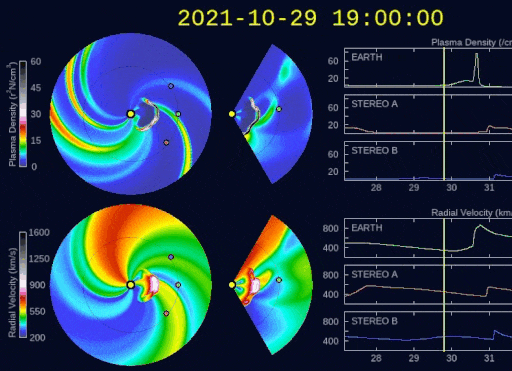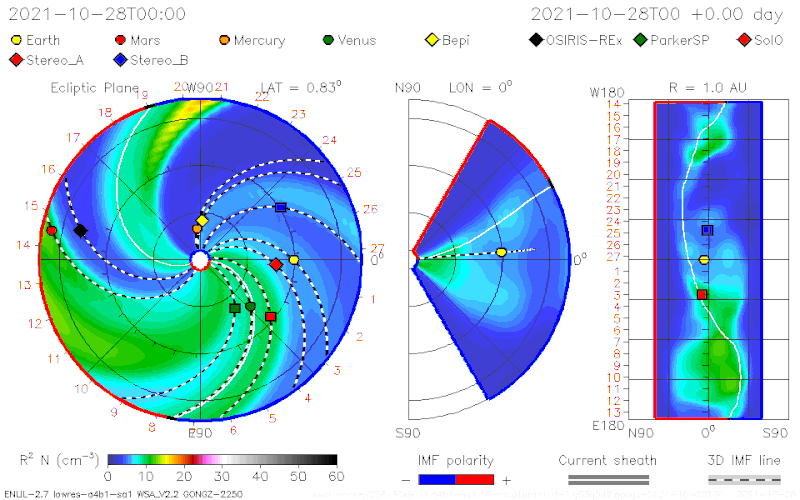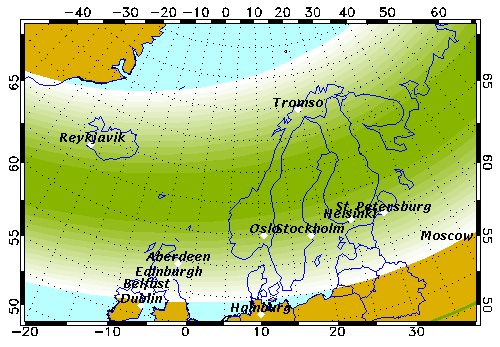The sun may be delivering a Halloween treat. Aurorae! The active region of sunspot group AR12887 (2887 for short), to the southeast part of the sun, fired off an X1 solar flare on October 28, 2021. This release of magnetic energy also pushed a billion tons of solar material and a magnetic field in a coronal mass ejection (CME) out into space. The solar plasma sped toward Earth at around 2.5 to 3.3 million miles per hour (1,100 to 1,500 km/s). This plasma cloud should reach Earth between midday October 30 to midday October 31.
The video here is a look at the initial eruption observed in several extreme ultraviolet wavelengths by the NASA Solar Dynamics Observatory (SDO).
Both NOAA and NASA model the trajectory of the CME using a computer model called WSA-ENLIL. Both models are predicting the impact to be today, October 30, or tomorrow, October 31. They have timing errors of roughly plus or minus 7 hours.
The 2022 lunar calendars are here. Order yours before they’re gone!


Solar storm to bring widespread aurora
When the solar plasma impacts Earth’s magnetic shield or magnetosphere, scientists predict it will create a geomagnetic storm at the moderate to severe level. On NOAA’s geomagnetic storm scale, this is G2 to G4. That would mean aurorae visible down to New York, Idaho (G2), Illinois, Oregon (G3), or Virginia, Maryland and Nevada (G4). From farther south, you would look to your northern horizon from a location free from light pollution. Those at higher latitudes could see a great show, especially observers in Canada, the Upper Peninsula of Michigan, Alaska, Iceland, Norway and Scotland, etc.
Here are the auroral oval forecasts from the University of Alaska, Fairbanks, for Alaska, North America and Northern Europe. The thin green line shows the estimated extent of the aurorae on the horizon. The green band is the auroral oval overhead.



The strength of solar flares
The solar flare is the second largest of this solar cycle. The first happened on July 3, 2021, with an X1.6 flare. Flares are rated by their x-ray intensity as measured by the NOAA GOES spacecraft. The smallest is A1, B1 is 10 times stronger than A1, followed by C1, M1, and X1. Each category increases by a factor of 10. So an X1 flare is 10,000 times stronger than an A1 flare.
Earth experienced similar activity, though on a much larger scale, with the famous Halloween Storms of 2003. The sun produced a series of solar flares, CMEs, and particle events from mid-October to early November. During this period, the largest solar flare recorded in the space age occurred on November 4, 2003. It was so bright that it went off the scales for the GOES spacecraft. That flare was 28 to 45 times more intense than the recent October 28 X1 flare. During the 2003 Halloween storms, the inner solar system experienced a great deal of space weather, including here at Earth and at Mars.
The eruption on October 28, 2021, also produced a solar energetic particle event or SEP. Such an event consists of high-energy particles, mostly protons, that are accelerated by the flare and CME to near-relativistic speeds (near the speed of light).
Geomagnetic storm’s impact
Besides the aurorae, the impact of these events will probably be minimal. The X1 flare caused a radio blackout for about one hour or so on the sunlit side of Earth. NOAA’s scale for these blackouts is R1 to R5. This blackout, at level R3, impacted high-frequency radio and low-frequency navigation signals.

As of October 29, the SEP is ongoing. NOAA rates these events on a radiation storm scale of S1 to S5. This event is a minor or S1 storm. It will have a minor impact on high frequency radio in the polar region. It could have a minor impact on Earth-orbiting spacecraft.

Good luck aurora watchers! Keep an eye on the aurora forecast and also check out Space Weather for updates.
Bottom line: A solar storm after an eruption on the sun is carrying plasma toward Earth, which should produce northern and southern lights this weekend.











